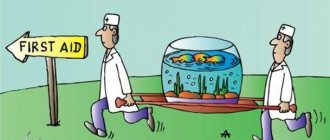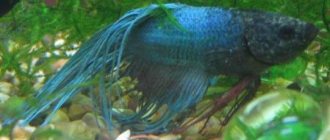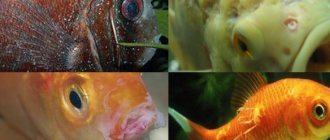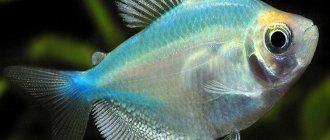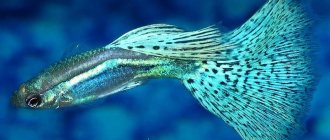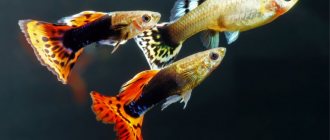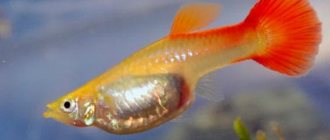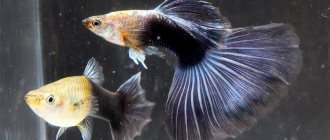Incorrect water temperature or dirty filter
The optimal climate is from 20 to 25 degrees. It should not be allowed to cool down to 18 degrees; in cool water, guppies’ immunity weakens and they can get sick. High temperature (from 26 degrees) is also undesirable. Pets live less in it. For example, at a temperature of 22 degrees, a guppy will live for two years, and at 28 - only one.
Read also: Why should girls pluck their eyebrows?
In warm water, bacteria multiply faster, and there is less oxygen, but more toxic substances. To prevent the water from overheating in the summer, there are special fans that lower the temperature by a couple of degrees. It is very good if the room has air conditioning. In winter it is enough to simply ventilate.
Bacteria form on the cleaning system. Such microorganisms are always present in water, but an imbalance (an increase in the number of microbes) leads to illness and death of the fish. It is necessary to clean and change the filter promptly.
Causes of death of Poecilia reticulata: water pollution
Recommended parameters for keeping guppies : temperature 22-26 o C, acidity of the environment 7.0-8.5 pH, hardness - 10-18 o. With sudden changes in environmental conditions, the fish will begin to get sick. Also, in the absence of weekly 20% water changes with fresh and clean water, guppies will actually breathe their own waste. The lack of high-quality filtration and aeration will also negatively affect the life of fish.
Watch a video with recommendations for keeping guppies .
Birth of fry
A pregnant female guppy looks different from other fish. Her belly is greatly enlarged and the dark spot near the anal fin is enlarged. The behavior of the fish also suggests that it will soon give birth: it becomes restless, tries to retire, hide in the thickets of plants. Having noticed such features, the aquarist must take measures to preserve future offspring. First of all, you need to move the female to a separate aquarium. This should be done in advance so that the guppy adapts to new conditions. At the same time, premature birth must not be allowed, otherwise the premature fry will die.
Attention! If the right moment for hatching is missed, allow the fish to breed in a community aquarium. After birth, the fry must be carefully caught with a plastic glass and released into a prepared tank.
Deviations in guppy behavior
When adding new fish to the aquarium, remember that the fish have an adaptation period of two weeks. They may not be eating well these days. You can notice that the fish move in jerks, sometimes slowing down in place - this is also a sign of adaptation.
If guppies freeze in the corner of the aquarium, often near the filter, this is an indication that the biobalance in the aquarium is disturbed. When an individual lies on the bottom, it gets sick. Sometimes you can notice that the fish swims from top to bottom, as if vertically - this is how it plays and has fun. If pets rise to the surface of the water, they lack oxygen.
Guppies are rubbing against the decorations - there is an increased concentration of ammonium in the water, or they have skin parasites.
Also, novice aquarists often do not understand why guppies bite everything. Such behavior is not a violation. There are microorganisms on the walls and bottom of the aquarium, on decorations, plants and other objects. Pets eat them, thereby supplementing their diet with the necessary components.
What is the reason for this trouble?
Naturally, the reason for guppies dying may be simple biological death. An organism that has outlived its natural resource wears out, grows old and ends its life activity. The lifespan of healthy individuals is statistically on average 3-4 years, but more often – one and a half to two years. It’s another matter when a young individual swims on its side, which just yesterday was cheerful and healthy.
What could have made her sick? After all, care has not changed in any way.
The aquarium also has its own tasks, leading to diseases of its inhabitants. Knowledge of their circumstances will allow timely measures to be taken to prevent such negative consequences.
Fin split
Splitting most often occurs at the caudal fin. Prerequisites:
- sudden change of water;
- injuries;
- mismatch of water characteristics.
When do the chicks hatch?
The female incubates the eggs for about 3 weeks and to ensure that the future chicks develop correctly, she constantly turns the eggs, warming them evenly on all sides. It leaves the clutch only to satisfy hunger and thirst, as well as to empty the intestines. During this short time, the eggs do not have time to cool.
However, it also happens that the female abandons the clutch. If you want to breed parrots, then your task is to warm the eggs, place them in an incubator.
The chicks hatch in the order in which the eggs are laid. The female feeds them with crop milk and warms them under her wings. The male is located not far from the nest, he can bring food to the female, and sometimes he can incubate eggs when she has been away for a long time. The process of feeding the chicks lasts from 1 to 2 months until they leave the nest. At this time, the nest should be removed so that the couple does not want to reproduce again. Now the female needs rest, after laying she needs to recover.
Nitrogen poisoning
If you notice that fish in your aquarium have begun to die, one of the possible reasons is poisoning with nitrogen compounds. During the life of aquarium fish, a large amount of organic matter accumulates in the water - nitrates, nitrites, ammonia.
Without exception, all nitrogen compounds are very toxic and poisonous to the inhabitants of the aquarium. Ammonia is especially dangerous. Its excess in the aquatic environment can cause mass death of the entire aquarium population.
Breakdown of filtration systems, overcrowding in the aquarium, poor aeration, overfeeding are factors that contribute to an increase in nitrogen in the aquatic environment.
You can determine excess nitrogen compounds in an aquarium by the state of the water, namely by smell and color. If the aquatic environment is cloudy, or an unpleasant putrid odor is coming from the aquarium, this means that measures need to be taken to normalize the condition of the aquatic environment. Even if the water is visually clean, but there is a smell, this means that the ammonia process has started.
External filter for an aquarium To normalize water parameters and eliminate ammonia compounds, replace ¼ of the water in the aquarium and increase aeration. You only need to add water that has been standing for 24 hours.
Nitrogen compounds appear in water as a result of the breakdown of waste products of its inhabitants, due to poor purification. Nitrites and nitrates are especially toxic. An increase in their number is accompanied by the appearance of rotten odors, and the aquarium becomes cloudy. Bacteria that process waste products into the nitrogenous compounds described above settle in filter media and soil.
Back problems
Curvature of the spine is common among guppies. This pathology can be either acquired or congenital. In the first case, you can fight it, in the second, you can’t.
There are two types of spinal curvature:
- Downward curvature;
- Curvature to the side.
If the spine bent down suddenly, not from birth, then the fish’s nutrition should be adjusted and given less food.
There are several reasons for acquired sideways curvature of the spine:
- Overpopulation of the aquarium;
- Infection with infectious diseases;
- Increased water hardness.
If the guppies do not show other signs of infection with a dangerous disease, then the number of fish in the aquarium should be reconsidered or the water hardness should be corrected. Otherwise, the sick animal should be temporarily quarantined in a separate container and closely monitored.
Congenital curvature of the spine
Scoliosis, which manifests itself in juveniles, cannot be treated. Individuals with this disease are often weaker than their brothers and sisters and are more susceptible to various infections.
The reason for the birth of fry with back problems is insufficient aeration of the reservoir where the pregnant female was and her unbalanced diet, which contains little protein.
First aid
Not all diseases of aquarium fish are curable. There is no universal method to help with those ailments that can be treated. However, any aquarist should know a number of initial measures to help a sick fish.
- It is best to remove a sick fish from the general aquarium in order to carry out treatment. This way she won’t infect others, and it will be more convenient to treat her.
- When preparing a fish tank (for guppies, a regular jar with a capacity of 2 liters or more is enough), use water from a common container, mixing it with fresh water.
- The water in the reservoir is changed daily. Aeration is not necessary.
- The water should be salted - 1 gram per liter, and add a few drops of iodine. When changing the water, the concentration of nutrients should be restored.
- It is best to feed a sick pet with live food - it is more nutritious and will allow her to recover faster. Bloodworms are perfect.
- The volume of water in the hatchery is very small, it spoils easily, so feed carefully and immediately remove uneaten food debris.
- Such measures are only first aid; then, having accurately identified the disease, more serious treatment can begin. However, in cases that are not too severe, the first measures can help.
Treatment of most guppy diseases involves the use of specialized antibacterial drugs. But it is much easier to prevent problems than to treat them. Guppies are hardy fish, and in good conditions they rarely get sick. High-quality food, aeration, and timely water changes are the best prevention against all diseases.
Causes
Tetrahymena were first described three hundred years ago. The peculiarity of these ciliates is their ability to quickly reproduce and “kill”.
For some time now they have been common in Russian aquariums and cause a lot of problems even for experienced owners.
Ciliates are capable of parasitizing not only on the host’s body, but also penetrating internal organs, muscle tissue and the brain.
They eat the fry almost entirely. They also parasitize small marine animals and are found in the bodies of dogs and even humans.
And in warm tropical conditions, where aquarium fish are grown for sale, they feel more than comfortable, so the pathogen can be found in every sixth guppies imported from abroad.
Ichthyophthiriasis (semolina)
The invasive disease is caused by the single-celled protozoan parasite Ichthyophthirvus multifiliis. You can tell that a fish is infected with semolina by the white grains on its body that resemble semolina. The body is covered with a bluish coating. The disease is characterized by an aggressive course, rapid spread and can be treated only in the early stages.
Treatment: salt is gradually introduced into the aquarium, since acidic and salty environments have a detrimental effect on parasites. For 4 liters of water, 5 teaspoons of salt are required. Methylene green, iodine, furazolidone, bicillin-5, Contractal, Omnisan, Kostapur, Tripaflavin are used in treatment.
During treatment, it is best to place sick specimens in a separate tank (sea tank). It is mandatory to warm up the water and carry out complete disinfection in the aquarium.
Semolina
Other causes of death
Other reasons that cause guppies to die one after another may include heavily contaminated filter media. Bacteria necessary for the biological balance of substances in water multiply on the filter sponge, the violation of which leads to illness or death. Therefore, replacing or cleaning the filter will help keep your fish healthy.
Overfeeding is one of the most common causes of death of aquarium fish.
Often the cause of the disease is too frequent feeding - excess feed begins to decompose and release harmful substances. The water becomes cloudy, its performance deteriorates, the microflora is disrupted - all this leads to the fact that the fish die.
Also, fish can die due to incompatibility with other inhabitants of the aquarium. Guppies are peaceful fish that do not cause any disturbance to their neighbors, but for predatory species or fish much larger than guppies in size, they can become food or will always remain hungry.
What to do if guppies die?
Unfortunately, sooner or later aquarium fish die. The most common reason is wear and tear of the body, and as a result, its old age. Life expectancy depends on many factors, but it has been proven that large fish live longer than small ones. As for guppies, they are small fish that in an aquarium can grow to the size of 5-7 Washing machine in length. They live relatively short: 3-5 years. Why do these fish die in the aquarium?
Why do fish die in an aquarium?
Why do fish die in an aquarium?
- Like all the abodes of our planet, fish need air, they need aeration of water. Before moving in, always check the cleanliness of the air and water. Fish often die in an aquarium from lack of oxygen. This happens when you put a lot of inhabitants in an aquarium that is too small.
- But even if all the rules are followed, sometimes the fish die immediately after settling. This is due to the fact that they have a simple shock of adaptation. That is why you cannot release your pet into a community aquarium immediately after purchase.
- The next reason why fish die in an aquarium is the introduction of one or another disease. Typically, you will notice a gradual deterioration in the fish's condition, with the disease primarily affecting one species.
- Never neglect aquarium lighting. This is especially true for lovers of colorful tropical species. Daylight hours for such fish should last about 12 hours. If there is a lack of light, the pet's biological clock will break, which will lead to death.
- The temperature of the water is no less important than its composition. It is generally accepted that a couple of degrees will not significantly affect the condition of aquarium inhabitants. Meanwhile, fish are very sensitive to the slightest changes in temperature, so constant fluctuations in degrees can become a serious threat.
- Fish die in an aquarium if the recommended water composition is not followed. When purchasing a new species, be sure to carefully study the water characteristics that are recommended for it. The hardness of the water directly affects the condition of the pet; if the water is too soft or hard, it is almost a guarantee of death.
- Quite often problems arise when incompatible species are introduced. This statement is true for both carnivorous and herbivorous species. And sometimes only one type of fish dies in an aquarium, while the rest feel quite normal. It is likely that changes in the composition of the water have occurred, which for some fish are insignificant, but for others they cause death.
- If fish die in a new aquarium and all water parameters and selection rules are met, you should pay attention to the feeding regime. Beginners often make do with only dry food and simply throw in a handful of granules. After a while, this regime causes inflammation of the fish’s stomach and they die en masse. In fact, your pets need a varied diet. Add plant and live food to your menu.
Why fish die in an aquarium: forewarned is forearmed
To prevent such problems from arising, it is necessary to take the filling and maintenance of the aquarium seriously. Before you go in search of fish, do not be lazy to read enough literature about the features of their maintenance. Often we try not to follow such a simple rule and simply find out the details from the pet store seller.
Most often, the reasons why fish die in an aquarium are related to maintenance violations. Always keep control of all water parameters in the aquarium, monitor any changes in the behavior and condition of your pets. These simple rules will allow you to notice the beginning of a problem in time and solve it in a short time. The fish cannot tell you, but by its behavior you will always notice something is wrong.
>
Guppies are dying in the aquarium - what to do
Message body: Hello! Help, please, I don’t know what to do anymore... Aquarium 150 liters. (this is minus the soil, decorations, etc.) They live: guppies - 5 adults, other fry, 5 neons, 2 danios, 2 catfish - speckled and golden, 2 huge ancitrus and fry (they breed like rabbits for me , every month 30-50 pieces). Filter for 150-250 liters, heater, bottom siphon, water change once a week.
About 1.5-2 weeks ago I saw fin rot in the guppy. I treated it with ANTIPAR for about a week. The water became completely bad, I began to notice that the guppies were dying, no longer “gnawed” by this rottenness, but completely healthy in appearance, and the rest of the fish felt bad in this water, I decided to replace all the water, and if the guppies were not cured, then in a small amount in the aquarium to finish treating them. I planted them in 2 aquariums of 30 liters each. every. Ancitrus in one, all others in another. While I was washing the large aquarium for 2 days, the ancitrus in the small one began to die. Well, apparently there wasn’t much room for them at all; they were hanging on the wall opposite the filter, at the water’s edge. Quickly, I filled a large aquarium with water, added AGUASAFE according to the instructions, let it sit for another day with the filter on, and put them all in there. The next day, I just raked out a bunch of dead ancitrus... And they also continue to hang on opposite the filter at the water’s edge. I replaced some of the water, removed the excess food, but they still died. I decided that they didn’t have enough air. I read that it is impossible to oversaturate water with oxygen, so I hung up 2 more filters from small aquariums, 50 liters. each is calculated. They still hang at the edge. Well, the guppies are behaving somewhat restlessly. Sometimes they lie on the day, sometimes they rush about in a stream of bubbles. Neons and danios seem to behave normally, adult ancitruses too, the male hatches the eggs again, and the female either crawls out or climbs back into the house. There doesn’t seem to be any plaque on the fish, nor mucus. anything new to the aquarium , only the filter was slightly cracked and I covered it up a little with plasticine, well, I’ve already picked it back, thought about it, maybe it will release something and they will be poisoned. Yesterday evening we ate everything normally, both ancitrus and other fish. And now exactly what happened to them...the heart bleeds to pull out small corpses...
We respect ladies who are not afraid of huge aquariums! You are just great for being concerned about the problem and not giving up everything, but continuing to fight.
Although you write everything quite carefully, for which special thanks, you do not indicate the most important thing - you do not indicate what is wrong with the water parameters... In similar situations, it does not matter what ails the fish to do an analysis for nitrates, nitrites, ammonia - this is a must. After all, poor water quality can become, if not a prerequisite for a disease, then one of the circumstances that provokes it.
Judging by what you wrote, the fish die without being nibbled, we are talking about either nitrate poisoning, or some kind of incurable disease, like fish tuberculosis. But tuberculosis does not wipe out all residents - it only happens to those who have weakened immune systems.
We are inclined to believe that these are all problems with water quality. With all this, you write that you transplanted the fish into 2 other aquariums, but you must realize that in these aquariums there must certainly be clean, settled water, as well as real filtration and aeration.
What can be recommended in a similar case:
- Be sure to always keep the water characteristics under control.
- Do not overfeed the fish, because there is a possibility that the fish simply did not manage the food, as a result - a sharp deterioration in the condition of the water and a loss of bio-balance.
- Try not to drain all the water completely and add new water at once - this way you will completely kill all the beneficial bacteria that could still remain in the water.
- Naturally, we also do not recommend using plasticine - there are special harmless sealants for aquariums for this.
Diseases of ornamental fish
Usually neither sellers in pet stores nor breeders want to blame themselves for the death of fish. Everyone is guilty of illness. If the guppy died gradually, and not in an instant, then it really is a disease. There are various medicines for ornamental species, but before you buy them, you need to be sure of the diagnosis.
Now about what diseases are usually found in guppies.
Dermatomycosis (saprolegniosis) - the disease appears if the fish has been in cold water for a long time. The infection spreads very quickly. The first sign is the appearance of a coating on the scales in the form of moss and white threads. What to do if guppies die in an aquarium from ringworm? This issue requires an urgent solution. Infected fish must be isolated immediately. The fungus can be removed with bicillin.
Gyrodactylosis - a whitish-blue coating appears on the guppy, the eyes become cloudy, and the fins shrink. The causative agent of this disease is the parasite Gyrodactylus. A sick pet must be placed in a container with a special solution: 1.5 mg of copper sulfate per liter of water. Without fish, the parasites will die on their own within a week. The aquarium for fry must be treated with table salt.
Diseases
The list of diseases of aquarium fish is huge; experienced aquarists and people with special education understand them. If you lack experience, it is better to consult a doctor.
Fin rot
The disease appears in dirty water when the fins are injured. If you ignore the disease, after the destruction of the fins, damage to the body will begin and the fish will die. Fin rot is treated:
- Salt baths. Immerse the sick individual in a solution of table salt (3 tablespoons per 5 liters of water) for 10–15 minutes. Treat the decorations and soil.
- Levomycetin. Dissolve 1 tablet for every 20 liters of water. Once every three days, add a solution in an amount of up to 30% of the aquarium volume. Carry out treatment until complete recovery.
There are many methods for treating fin rot. The treatment is discussed in detail in a separate article.
Plistophorosis
The disease is also called “neon disease” and pleistophorosis. The fish's muscles are affected and ulcers appear on the body. Plistophorosis cannot be treated; the diseased individual must be destroyed. Boil the soil and decor, rinse the aquarium.
Red scab
The disease most often affects males. Remove the parasite-affected areas of the fins with a blade. Place the guppies in salted water (1 g salt per 1 liter). Treat in combination with levomycin (1 tablet per 30 l) or furazolidone (0.5 tablets per 10 l). The course of treatment is 5 days. Remedies for ichthyophthyriosis also help. The tail grows back after some time.
Scoliosis
If the spine is curved, and no other symptoms of disease are observed, then the curvature may be congenital. Individuals with scoliosis can lead normal lives, but they are smaller and weaker than healthy guppies. Scoliosis that appears in an adult fish can be corrected by reducing portions during feeding and introducing variety into the diet. During pregnancy, the female monitors the aeration in the aquarium and does not allow inbreeding.
Tetrachymenosis
The ciliates Tetrahymena infect the gills and fins. Place the sick fish in salted water (1 g of salt per 1 liter) with increased aeration. Add a solution of biseptol (1 tablet per 50 liters of water) or furazolidone (0.5 tablets per 10 liters) into the water. Prevent healthy fish by mixing a small amount of furazolidone with food.
Tuberculosis or mycobacteriosis
In addition to weight loss and curvature of the spine, there is a fading of color. Treatment is possible in the early stages; a number of aquarists consider the disease incurable. Place the fish and add kanamycin (30–50 mg per liter) to the water daily for 10–14 days with daily water changes. You can soak the food in a solution of kanamycin (0.5 g of the drug per 100 ml of water). Another method: adding isoniazid (1 tablet per 60 l) for 3 days. Then a break is taken for 2 days. The course is repeated 2-3 times. After transplanting the sick fish, disinfect the aquarium, wash the decorations and boil the soil.
Dropsy ascites
In addition to the abdomen, fish have enlarged eyes. Guppy tends to hide and spend more time at the bottom. Dropsy appears for various reasons:
- overfeeding;
- abuse of dry food;
- poor quality food;
- virus infection;
- low water quality.
Treat dropsy with frequent changes and adding salt to the water (1 tablespoon of salt per 10 liters). Put your guppy on a hunger strike for a couple of days and review its diet. Increase aeration and add antibacterial drugs, for example, chloramphenicol (mix 250 mg of the drug with 25 g of feed or 10 mg per 1 liter of water).
Trichodinosis
The parasitic disease is most dangerous for fry. Damage to ciliates begins with the fins, and in the last stages the gills are affected. Raise the temperature and increase aeration. For every 10 liters of water add 1 tbsp. l. salt. Use malachite green or methylene blue in proportions of 5 ml per 10 liters of water.
Columnaria
Advanced disease is accompanied by ulcers. You can cure it with bicillin-5 (one-third of a bottle per 100 liters of water, shade the aquarium during exposure) and methylene blue (5 ml per 10 liters of water).
Ichthyophthiriasis (semolina)
Carry out treatment in salted water (1 teaspoon per liter of water) with an increase in temperature by 2-3 degrees. Use biomycin and trypaflavin, course of treatment for 2 weeks. You can read more about the disease ichthyophthyriosis in another article.
Oodiniumosis
“Velvet rust” is treated with copper sulfate (0.2 mg per 1 liter of water) with an increase in temperature. If oodiniumosis is not completely eliminated, repeat treatment after 2–3 days.
Costiosis
In addition to plaque and inhibited behavior, the disease is characterized by protruding, pale gills. In the early stages, treat costosis with malachite greens in accordance with the instructions. Salt baths with potassium permanganate (1 teaspoon of salt per 1 liter of water, potassium permanganate until slightly pink) for 10–15 minutes are effective.
Hexamitosis
Spironculosis, octomitosis or hole disease is a rare disease for guppies. It is treated with metronidazole (250 mg per 35 liters of water) with water changes.
Hermaphroditism
It cannot be treated and is not noticeable externally. Self-fertilization rarely occurs in females, and the offspring are infertile.
Diseases and treatment
Diseases of guppies can be either non-infectious, associated with errors in the maintenance and diet of fish, or infectious – caused by various parasites. In most cases, fish can be helped with antibacterial drugs and antibiotics, and improved care.
- Guppy infertility. Female guppies become unable to give birth to fry. The color of the fish fades, especially shades of red disappear in the color. This is due, first of all, to prolonged over-lighting in the aquarium. “Daylight” for guppies takes no more than 10-12 hours a day. By adjusting the lighting in the aquarium, the owner can hope that bright colors will return to the fish, but infertility, alas, is incurable.
- Poor growth of males. It happens that fry, especially male guppies, grow poorly, do not reach their full “adult” size, and their color becomes faded. This is due to the fact that during the period of intensive growth they are in an aquarium with poor aeration. Before maturity, the situation can be partially corrected by adjusting the water supply in the aquarium.
- Hermaphroditism. A phenomenon in which females develop a testis, a male organ, along with the ovary. There may be cases of self-fertilization of such fish. The overwhelming percentage of offspring, as a rule, have the same “bisexual” characteristics. And a small number of males are born sterile. The phenomenon and its causes have been little studied.
- Dropsy (ascites). Dropsy is an intestinal disease. The main symptoms that characterize dropsy are a swollen abdomen and ruffled scales. The fish tries to go down and hide. Dropsy also causes bulging eyes. Dropsy is a viral disease that can be treated with antibacterial drugs and frequent water changes.
- Tetrachymenosis is a specific disease of guppy that is rarely found in other fish. The causative agents are tetrahymena, small ciliated ciliates. Tetrahymena feed on both microorganisms and tissues of multicellular creatures, which invariably entails the possibility of infection. Tetrahymena infects the most vulnerable parts of guppies - the slimy gills and fins. On the surface of the body of a fish that has been struck by tetrahymena, a white mucous coating is clearly visible, which then slides off in flakes, the scales become ruffled and the gills protrude. Later, tetrahymena penetrate deeper into the “host’s” body and begin to devour it from the inside. At this stage, patients may experience bloating. Tetrahymena fry can be eaten almost completely. Tetrahymena are destroyed by furazolidone and biseptol, which are dissolved in water. The drugs are harmful to plants, so it is better to treat them in a nursery. Tetrahymena are dangerous not only for guppies, but also for their neighbors - for example, labyrinth fish. Therefore, healthy pets are recommended to undergo prophylaxis by adding furazolidone to their food.
- Fin rot. Rot affects the fins and is expressed in the disintegration of the interray tissue. At an early stage, rot can be difficult to notice - it simply looks like a slight clouding along the edge of the fins. However, it is at the very beginning that it is easiest to cope with the disease. It is enough to improve the conditions of keeping the fish, add salt and change the water more often, increase the oxygen supply in the aquarium and the quality of food for fin rot to go away. In more advanced cases, fin rot is treated by adding antibacterial agents to the water - streptocide, biomycin, bicillin-5. Fin rot takes a long time to cure – up to three months. Keep in mind that an outbreak of this disease usually indicates poor aquarium maintenance. Guppies are sensitive to aeration and freshness of water. Fin rot usually begins when the water stagnates for a long time and begins to deteriorate.
- Mycobacteriosis or fish tuberculosis is a dangerous and extremely contagious disease. A fish that has been affected by tuberculosis rapidly loses weight, sucks in its stomach, hunches over, becomes dull, becomes apathetic and tries to hide, and swims down to the bottom. Tuberculosis has another obvious sign - the eyes turn black. Tuberculosis is considered incurable. Pets affected by it should be destroyed and the aquarium should be disinfected. However, many amateur aquarists argue that tuberculosis can be stopped by the use of antibiotics mixed into fish food. There is no exact scientific data on this issue, but cases of rapid improvement in the condition of “patients” affected by tuberculosis have indeed been recorded. However, keep in mind that a fish that once contracted tuberculosis will never regain its full physical form. In addition, her immunity will be undermined and tuberculosis may return at any time.
- Trichodinosis. The disease can be difficult to identify in its early stages. Its main symptom, a grayish-blue coating that appears on the surface of the body, the stomach, affecting the gills of the fish, is barely visible. Therefore, it is easier to diagnose the disease by the behavior of the fish: they go down, rub against stones and decorations, try to swim into aeration bubbles, as if they are itching. Guppies can also stand still while swaying. Trichodinosis is especially dangerous for juveniles and fry of guppies. It is treated by heating the water to 33-34 degrees, adding salt or methyl blue to the aquarium. It is imperative to increase the aeration of the aquarium: in warm water, oxygen dissolves much less well, if its supply does not increase, the fish may simply suffocate.
- Plistophorosis is another incurable disease. The main sign: guppies swim vertically, with their heads raised and tail down. Pets lose their appetite, the color of the body surface becomes faded, and the stomach retracts. Plistophorosis cannot be treated; all sick fish should be destroyed, the container where they lived should be thoroughly disinfected, and the soil should be boiled.
- Red scab. The disease affects male guppies, starting from the tail, manifesting itself in the form of red rashes on the surface of the fin and its splitting. Treatment is possible if the red scab affects no more than half of the tail. The diseased part of the tail should be removed with a sharp blade, and the fish should be placed in salted water. This is done so that the injury on the tail heals faster. Aeration in an aquarium with a sick fish should be increased as much as possible - its living conditions should be optimal in order to quickly recover from the “surgery” of the tail. Even if you have recorded a case of tail disease in only one fish, be sure to pay attention to the tails of others after it has been cured in order to prevent an epidemic in time.
- Scoliosis or curvature of the spine. The disease occurs in guppy fry and is a curvature of the fish’s spine, its smaller size, and a retracted abdomen. This is a congenital defect that presumably occurs due to insufficient aeration of the aquarium in which the pregnant female is kept and inadequate nutrition. Spinal curvature cannot be treated. A spine bent by disease remains that way forever. As a rule, fish with a curved spine are smaller and weaker than their peers, and are more susceptible to infections. Guppies with deformities are discarded from selection.
- Ichthyophthirius multiphyliis or guppy disease. Characteristic specifically for this type of fish. Affects the body, stomach, and gills of guuppies. In the early stages, the fish show signs of itching, then whitish rashes appear on the surface of the body. The rash increases over several days. When the rash affects the gills, respiratory function is impaired. Lethargy, apathy, and loss of appetite also appear. The fish may tend to go down, closer to the bottom. Scales rise on the surface of the body. It is treated with specialized medications or formaldehyde baths. In the case of formaldehyde treatment, it is important to use a fresh solution each time - “old” is poisonous to fish.
Reproduction problems
It is necessary to create more comfortable conditions for pregnant guppies, especially before giving birth.
Guppies breed well in home aquariums. They reach sexual maturity at 4 months. It is not necessary to create special conditions; the couple will produce offspring even in an ordinary three-liter jar. But there are some points to consider:
- When the temperature in the aquarium drops to 18°C, fish may stop reproducing, as cold water reduces their reproductive functions;
- How long a female’s pregnancy will last also depends on the temperature and is approximately 30-35 days;
- You can find out that mating has begun because the male begins to chase the female. If there are a lot of males, then they can drive the female until she is completely exhausted . In this case, female guppies die.
During the gestation period, you cannot suddenly change the conditions in which the pregnant female is kept. She becomes especially sensitive before childbirth. Changes in water quality or temperature can cause the death of the fish.
In order for guppy fish to live long and not get sick, you must follow the general rules:
- You can keep fish with the same temperament and behavior together;
- Always keep the water clean and maintain the correct temperature and other parameters;
- Do not overfeed;
- Make sure that the fish are not crowded.
Guppies are very beautiful and unpretentious fish that, with proper care, will delight you for a long time.
Problems with reproduction
Aquarium guppies readily breed in captivity, but sometimes owners encounter problems in breeding their pets. The reasons why guppy fish cannot reproduce are:
- Infertility is a disease in which females are unable to produce offspring. At the same time, the color of the fish loses its saturation, the guppies become pale and dull. The causes of infertility are excessive duration of illumination or bright, powerful light. Unfortunately, it is impossible to get rid of this disease.
- Hermatophrodism - the disease is difficult to detect upon visual examination, since female guppies also develop male reproductive organs along with the female organs. The causes and treatments are not yet known.


